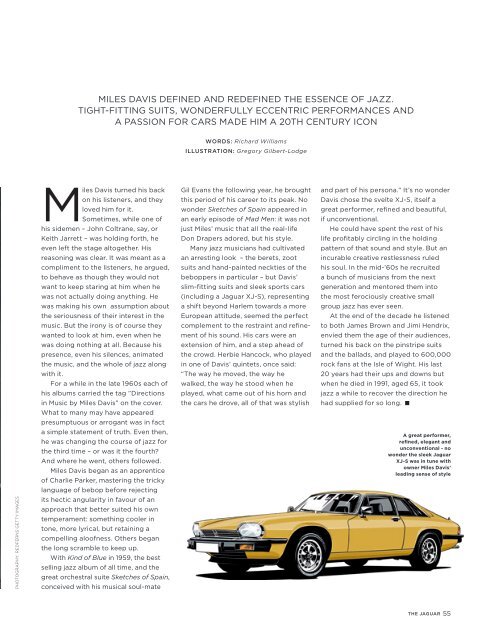Jaguar Magazine 03/2017 – English
Wir geben Gas! In London sorgt Automobiljournalist Guy Bird im brandneuen E-PACE für Aufsehen und zeigt uns ganz nebenbei nahezu unentdeckte Tipps in der britischem Hauptstadt – seiner Heimat. Warum sich der Jaguar XE bestens als Grundlage für den leistungsstärksten Jaguar mit Straßenzulassung aller Zeiten – den XE SV Project 8 – geeignet hat, hat uns David Pook erklärt, Leiter der Special Vehicle Operations bei Jaguar Land Rover. Lesen Sie mehr in der aktuellen Ausgabe THE JAGUAR 03.
Wir geben Gas! In London sorgt Automobiljournalist Guy Bird im brandneuen E-PACE für Aufsehen und zeigt uns ganz nebenbei nahezu unentdeckte Tipps in der britischem Hauptstadt – seiner Heimat. Warum sich der Jaguar XE bestens als Grundlage für den leistungsstärksten Jaguar mit Straßenzulassung aller Zeiten – den XE SV Project 8 – geeignet hat, hat uns David Pook erklärt, Leiter der Special Vehicle Operations bei Jaguar Land Rover.
Lesen Sie mehr in der aktuellen Ausgabe THE JAGUAR 03.
You also want an ePaper? Increase the reach of your titles
YUMPU automatically turns print PDFs into web optimized ePapers that Google loves.
MILES DAVIS DEFINED AND REDEFINED THE ESSENCE OF JAZZ.<br />
TIGHT-FITTING SUITS, WONDERFULLY ECCENTRIC PERFORMANCES AND<br />
A PASSION FOR CARS MADE HIM A 20TH CENTURY ICON<br />
WORDS: Richard Williams<br />
ILLUSTRATION: Gregory Gilbert-Lodge<br />
PHOTOGRAPHY: REDFERNS GETTY IMAGES<br />
Miles Davis turned his back<br />
on his listeners, and they<br />
loved him for it.<br />
Sometimes, while one of<br />
his sidemen <strong>–</strong> John Coltrane, say, or<br />
Keith Jarrett <strong>–</strong> was holding forth, he<br />
even left the stage altogether. His<br />
reasoning was clear. It was meant as a<br />
compliment to the listeners, he argued,<br />
to behave as though they would not<br />
want to keep staring at him when he<br />
was not actually doing anything. He<br />
was making his own assumption about<br />
the seriousness of their interest in the<br />
music. But the irony is of course they<br />
wanted to look at him, even when he<br />
was doing nothing at all. Because his<br />
presence, even his silences, animated<br />
the music, and the whole of jazz along<br />
with it.<br />
For a while in the late 1960s each of<br />
his albums carried the tag ”Directions<br />
in Music by Miles Davis” on the cover.<br />
What to many may have appeared<br />
presumptuous or arrogant was in fact<br />
a simple statement of truth. Even then,<br />
he was changing the course of jazz for<br />
the third time <strong>–</strong> or was it the fourth?<br />
And where he went, others followed.<br />
Miles Davis began as an apprentice<br />
of Charlie Parker, mastering the tricky<br />
language of bebop before rejecting<br />
its hectic angularity in favour of an<br />
approach that better suited his own<br />
temperament: something cooler in<br />
tone, more lyrical, but retaining a<br />
compelling aloofness. Others began<br />
the long scramble to keep up.<br />
With Kind of Blue in 1959, the best<br />
selling jazz album of all time, and the<br />
great orchestral suite Sketches of Spain,<br />
conceived with his musical soul-mate<br />
Gil Evans the following year, he brought<br />
this period of his career to its peak. No<br />
wonder Sketches of Spain appeared in<br />
an early episode of Mad Men: it was not<br />
just Miles’ music that all the real-life<br />
Don Drapers adored, but his style.<br />
Many jazz musicians had cultivated<br />
an arresting look <strong>–</strong> the berets, zoot<br />
suits and hand-painted neckties of the<br />
beboppers in particular <strong>–</strong> but Davis’<br />
slim-fitting suits and sleek sports cars<br />
(including a <strong>Jaguar</strong> XJ-S), representing<br />
a shift beyond Harlem towards a more<br />
European attitude, seemed the perfect<br />
complement to the restraint and refinement<br />
of his sound. His cars were an<br />
extension of him, and a step ahead of<br />
the crowd. Herbie Hancock, who played<br />
in one of Davis’ quintets, once said:<br />
“The way he moved, the way he<br />
walked, the way he stood when he<br />
played, what came out of his horn and<br />
the cars he drove, all of that was stylish<br />
and part of his persona.” It’s no wonder<br />
Davis chose the svelte XJ-S, itself a<br />
great performer, refined and beautiful,<br />
if unconventional.<br />
He could have spent the rest of his<br />
life profitably circling in the holding<br />
pattern of that sound and style. But an<br />
incurable creative restlessness ruled<br />
his soul. In the mid-’60s he recruited<br />
a bunch of musicians from the next<br />
generation and mentored them into<br />
the most ferociously creative small<br />
group jazz has ever seen.<br />
At the end of the decade he listened<br />
to both James Brown and Jimi Hendrix,<br />
envied them the age of their audiences,<br />
turned his back on the pinstripe suits<br />
and the ballads, and played to 600,000<br />
rock fans at the Isle of Wight. His last<br />
20 years had their ups and downs but<br />
when he died in 1991, aged 65, it took<br />
jazz a while to recover the direction he<br />
had supplied for so long.<br />
A great performer,<br />
refined, elegant and<br />
unconventional - no<br />
wonder the sleek <strong>Jaguar</strong><br />
XJ-S was in tune with<br />
owner Miles Davis’<br />
leading sense of style<br />
THE JAGUAR 55


















